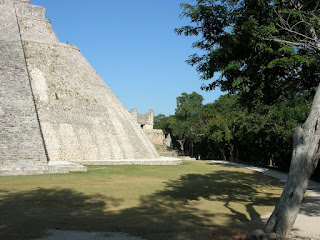 Last week Nancy and I spent a few days exploring the Yucatan Peninsula. In Santa Elena, a Mayan village south of Merida poised on the Ruta Puuc (Route of the Hills), we stayed at the sweet little Flycatcher Inn, which has its own trail through several acres of forest. It made for a pleasant hike and good birdwatching after five hours in the car. Although the town is normally quiet, we heard firecrackers throughout the night as townspeople warmed up for the annual celebration of the Virgin of Guadeloupe.
Last week Nancy and I spent a few days exploring the Yucatan Peninsula. In Santa Elena, a Mayan village south of Merida poised on the Ruta Puuc (Route of the Hills), we stayed at the sweet little Flycatcher Inn, which has its own trail through several acres of forest. It made for a pleasant hike and good birdwatching after five hours in the car. Although the town is normally quiet, we heard firecrackers throughout the night as townspeople warmed up for the annual celebration of the Virgin of Guadeloupe.The next morning we drove ten minutes to see the spectacular Mayan ruins of Uxmal, which fell into decline around 1000 CE. The site is impressive with its huge buildings and the wide expanses of well-tended lawns and shade trees. The view from the top of the palace is spectacular with ruins poking out of the surrounding forest.
One building that especially caught my attention was the Magician’s Temple. Its base is oval rather than the usual rectangle, as shown in the picture above.
 After Uxmal we took the Ruta Puuc to four other Mayan ruins, all of them amazing in their own way and quiet as few tourists visit them. Puuc architecture is a special Mayan style. One of its distinguishing characteristics is the rows of segmented columns that resemble bamboo poles.
After Uxmal we took the Ruta Puuc to four other Mayan ruins, all of them amazing in their own way and quiet as few tourists visit them. Puuc architecture is a special Mayan style. One of its distinguishing characteristics is the rows of segmented columns that resemble bamboo poles.At Kabah, Nancy and I ate a picnic lunch in the shadow of a tenth century arch that marked the beginning of the stone road that led to Uxmal 30 kilometers away. We gazed down the raised causeway that ended abruptly at the forest edge, where archeologists had stopped their work. What an impressive entrance to a city—it must have been like entering Oz. [The arch pictured is the one at nearby Labna.]
At all of these sites, stone carvings of Chac, the rain god, are in abundance. Since rain is the only source of water in this area, it is not surprising to find this god in such prominence. The Mayans built large cisterns to collect and hold rain water to see them through the dry season.
At the eastern end of the Ruta Puuc are the caves of Loltun. On the hour-long tour we saw huge caverns with many stalagmites and stalactites. The cave, used for millennia, has the outline of prehistoric hands similar to those in caves in France. Mammoth bones have been found in the Loltun cave, as well as human bones.

That night we were tired and missed the big celebration in front of the Santa Elena church (built at the top of what look like steps of a Mayan temple). Plenty of firecrackers went off during the night, though, so we didn’t entirely miss the party. The next morning as we walked around town we saw Mexican teenagers sleeping outside the public buildings, kids who had run or bicycled for days from other villages, carrying a torch to fulfill their pledge to the Virgin.
We stopped at a traditional Mayan home with palm fronds for a roof. A man came from the side of the house and told us that he teaches Mayan. Every year groups of students arrive from the States to learn the language which is spoken throughout the area and is still the first language of the town residents, Spanish being the second. We learned from our B&B host that Martha Steward filmed Don Feliciano and his wife last month as they taught her about Mayan cooking with traditional herbs from their garden.
Becky

No comments:
Post a Comment